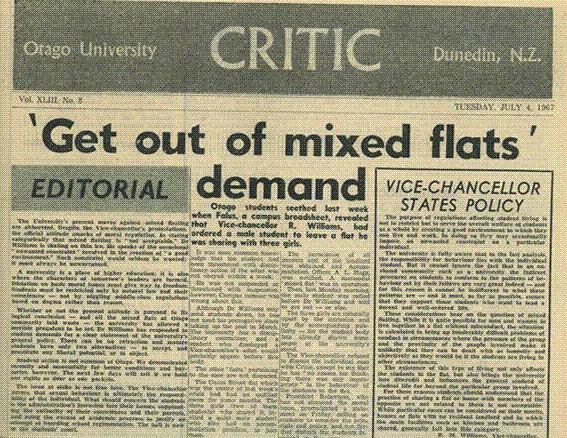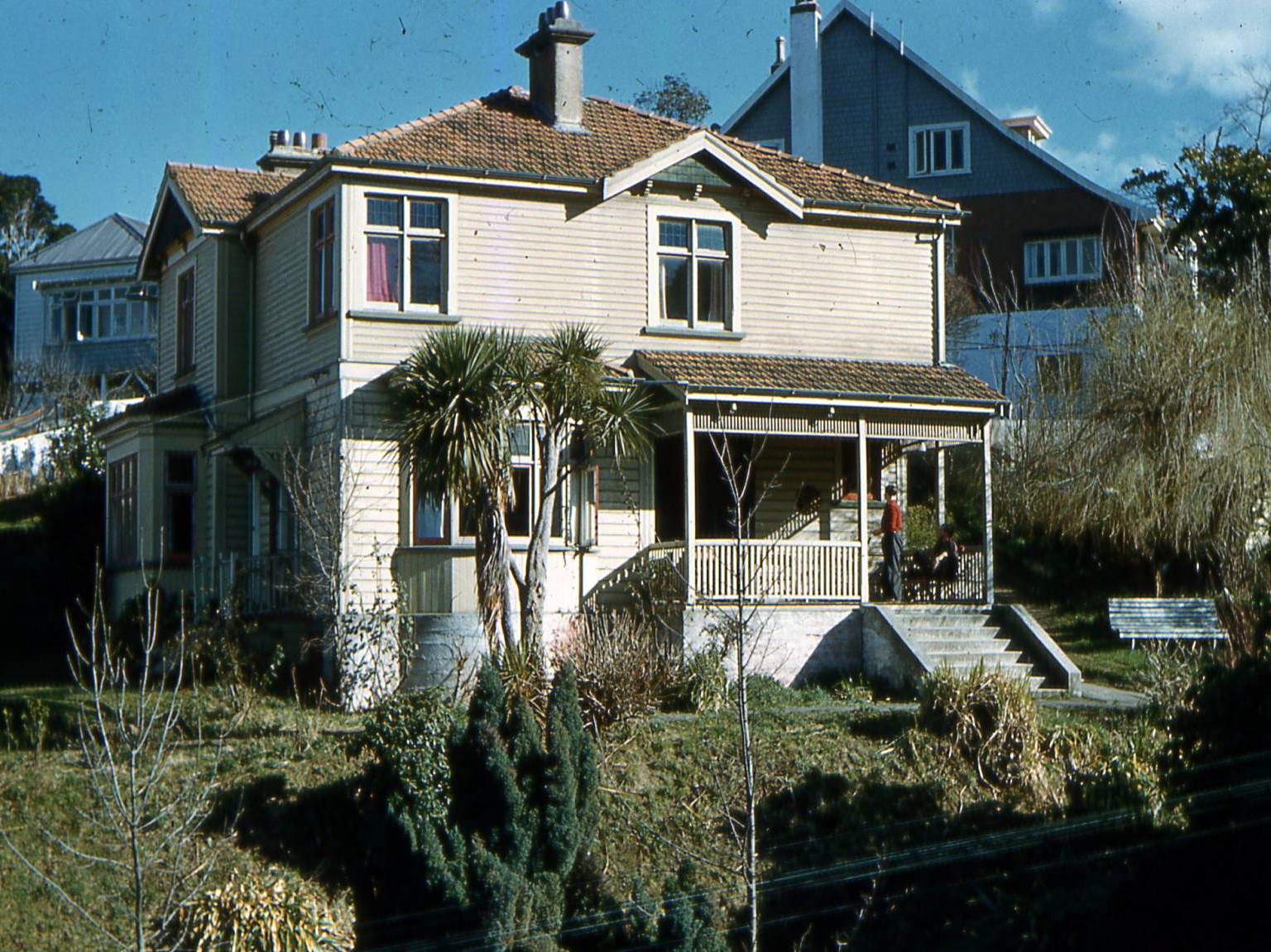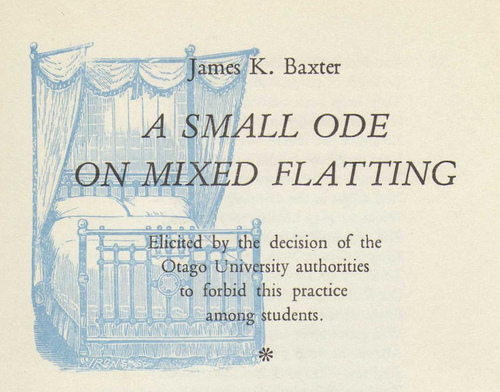Category: 1960s
Toad Hall addendum to “Scarfie Flats of Dunedin”
It’s the fate of authors investigating and relaying stories from the past; details will be missed, stories will be untold and some facts may be incorrectly reported. So much of this kind of research relies on finding people, or being found. It relies on getting in touch with, or hearing the people that lived there at the time, or who knew someone (who knew someone) – but sometimes that just doesn’t happen at all, or in the case of Toad Hall, didn’t happen in time.
In September 2019, Jim Scott submitted reminiscences about his time at Toad Hall, a time that began in late 1958. The story of Toad Hall features on pages 54-59, 22 and 238 of Scarfie Flats of Dunedin and describes the beginnings of the flat in the 1960s. Many thanks Jim, for getting in touch and contributing to the story of Toad Hall. Scarfie Flats of Dunedin was a snapshot in time, its great to continue the story here, online.
Toad Hall origin story
After three years of residence in Knox College, we five: John Allen [Medicine], George Salmond [Medicine], Fred Strange [Medicine], Jim Scott [Dentistry], and Lachie Watson [Law], left at the end of 1958 to “go flatting”.
John & George (he had a car!) were deputed to scout for a flat. They somehow secured the tenancy of 22 Pitt Street: rent payable immediately. The back story was that until recently it had been occupied by two sisters. One had died, and the distraught survivor kept her sister with her for several days.
We were all 21 years old; from similar backgrounds; and knew each other well from our time together at College. Perhaps that is why we thought nothing of the fact that we would now be living in a grand old Edwardian mansion; north facing; with splendid views to the Otago Harbour; and only five minutes’ walk from Medical and Dental Schools.
It had three large bedrooms, large sunny lounge, separate dining room, and ancillary staff and utility rooms. The bedrooms and lounge had minuscule fireplaces, so effectively there was no heating. The kitchen had a small 1920s free standing gas oven. In winter this was the warmest room in the house, and where clothes might be dried if you waited long enough.
Professor Bill Adams, Head of the Anatomy Department at the Medical School lived over the back fence. This encouraged circumspect behaviour than might otherwise have been lacking. Neighbours Mr & Mrs Laing were kind and tolerant, and a great help when we held dinner parties.
![Edwardian splendor in native timbers. Dinner party at Toad Hall. [Left-right] John Allan [standing], George Salmond, guest, Mr & Mrs Laing (neighbours). Jim Scott Collection.](/1833daf28b5283f1a3d468bc8edcdf40/2020/03/file0098.jpg?w=830&h=623)
Dinner party at Toad Hall. [Left-right] John Allan [standing], George Salmond, guest, Mr & Mrs Laing (neighbours). Jim Scott Collection.
![Dinner party at Toad Hall. [eLeft -right] Guest, Fred Strange, guest, John Allan, guest, Lachie Watson, guest, George Salmond. Jim Scott Collection.](/1833daf28b5283f1a3d468bc8edcdf40/2020/03/file1091.jpg?w=830&h=531)
Dinner party at Toad Hall. [eLeft -right] Guest, Fred Strange, guest, John Allan, guest, Lachie Watson, guest, George Salmond. Jim Scott Collection.
We trickled into occupancy during January 1959. The house had been cleared of personal belongings, but some serious items of furniture remained: a large Victorian dining table & chairs with a handsome sideboard, large wardrobes, several aspidistras, pedestal with clock, kitchen table & chairs, and threadbare floor coverings. Beds, study tables etc came with us from Knox.
The “garden” was seriously overgrown. Not a problem, as the umbrella stand [!] held five Samurai swords of varying lengths. One fine day we took to the grass and bushes with these and ‘tidied’ the section. The Victorian wooden fireplace surround and mantelpiece in the front room was lavishly adorned with turned finials & knobs. A few quick swipes with a sword and resulted in a more modern aesthetic. I wonder now at the value of those furniture chattels, and shudder when I remember our vandalism.
Like most student flats, we were a crash pad for out of town visitors, many of whom had been at school with one or another of us. This was particularly so during major events, and inevitably led to parties such as that after the All Blacks-Lions First test on 18 July 1959.[1]
Members of both teams arrived. Around midnight a voice was heard confiding in an Irish brogue that, “she asked for something to remember me by, and all I could give her was a bebe”.
Those were the days when men were expected to dress in sports coat collar & tie for lectures, which were also held on Saturday mornings. Although the flat had a washing machine, it was easier to use the bag wash at the bottom of Pitt Street. One could last a month with a wardrobe of at least 30 pairs of socks, and a half dozen drip dry shirts. The washing machine was electively out of action for a month while we experimented with home brew in preparation for a ‘garden party’. The resulting ‘beer’ resisted containment in bottles, but when imbibed was pleasingly soporific.
At the end of 1960 we passed Toad Hall to the next intake. Although it may have passed into Selwynite occupancy, it appears that it went to good hands.
Notes
[1] Read more about students and the All Blacks-Lions First test in, ‘The Shambles’, Scarfie Flats of Dunedin, pp. x-x.
Purple Orgy / Roger Wilco on Howe Street
Purple Orgy (1968) and Roger Wilco (1977) were situated at 57 Howe Street – later named Juice Box (2011) and more recently, Treasure Island (2016).
Purple Orgy
There nothing to verify the meaning of this name except for the purple paintwork.

Purple Orgy. 57 Howe Street. DCC Archives, City Planning Collection (c.1968)
Roger Wilco
See the flatties in 1977 along with their sign for the flat Roger Wilco (posted by Karin Williams).
May O’Hagan recalls living in Roger Wilco in 1978, “The huge sniff balls. The discussions on anarchy. And the green van inscribed with ‘I’d rather have a free bottle in front of me than a pre-fontal lobotomy’.” On questioning her about the nature of sniff balls, she elucidated, “We saved our roaches, then cut them up into little pieces, then wrapped them into a ball in cigarette paper. Stuck a needle in the ball (about the size of a marble), put a match to it and passed it around and sniffed it.” (Facebook comments 17 July 2015).
Kate Ryan “The flat actually had a painted sign that ran like a ribbon on one weatherboard at the front…..it said “Play is better than work”, I wonder if it is still there under the present paintwork, it had been painted directly on the house” Lachy Paterson “I think Karin painted that slogan, also from a Kliban book.” (Facebook comments 18 July 2015).
The flat, Roger Wilco, spawned more named flats across the country: Gumboot Wilco (Invercargill), Cousin Wilco (Palmerton), Island Wilco (Rarotonga), Country Wilco, and Wilco National Park (Auckland).
The origin of the flat name Roger Wilco was a cartoon character created by the American B. Kliban who was particularly popular in the late 1970s. You can see a picture of the Roger Wilco character in the The Stanford Daily, Volume 172, Issue 18, 18 October 1977, this image was reproduced from his book, “Whack your Porcupine”, 1976. Roger Wilco has an other meaning, it’s roots are in radio communications lexicon, a hangover from WW11 – Roger (acknowledge) Wilco (Will comply). It has a particular connection with airmen. It’s not known if there is a connection between this and Kliban’s character.
Kliban describes himself as a beatnik in the 1960s, wearing black turtlenecks and drinking a lot, which I’m sure, along with his art, was a point of connection for many students at the time.
‘Get out of mixed flats’ demand / Critic 4 July 1967

‘Get out of Mixed Flats’ demand [Critic, Vol XLIII, No. 8, July 4 1967]
“Otago students seethed last week when Falus, a campus broadsheet, revealed that Vice Chancellor R. Williams, had ordered a male student to leave a flat he shared with three girls.”
Source: OUSA Archives http://www.ousa.org.nz/history/archives/
Roger Donkin remembers The Shambles, 1960-62
Roger recalls a disastrous cooking/decorating experience at The Shambles. If you dare, here’s a recipe for ‘dough boys’ to try. No responsibility taken if they explode, of course.
Golden Dough Boys
2 c flour
1 t baking powder
pinch of salt
1 d butter
1 egg, beaten
Mix with enough milk to make a light dough and form into balls.
Put the following in a saucepan:
1 c sugar
1 c water
1 T golden syrup
1 T butter
Bring this to the boil and add the small balls of dough. Cook for 15 mins.
Roger Donkin remembers The Shambles, 1960-62
Feeling rather stoked
Shambles (1950s and 1960s)
Where Scribes Bookshop is now, on the corner of Great King and St David Streets in Dunedin, there was once a notorious flat, called the Shambles. It was well known for it’s parties and as a location to go to continue drinking once the pubs had closed.
It’s not entirely clear from where the name of the flat originated: it may have been the shambolic nature of the place itself, or it may, as has been suggested by a former resident, been named for a place in Manchester of the same name.
Shambles is an old name and derives from Viking word Shamel apparently meaning ‘bench’, ‘booth’ or ‘shelf’ and the name is found in many places in the UK where there are market places.
The most famous example such a place is the Shambles in York which is allegedly mentioned in the Doomsday Book, one of the few streets that is. This would make it over 900 years old.

This is a quintessential medieval street with upper storeys of buildings stretching out across the street precariously towards each other. The street was once a flesh market (hence also being known as Flesshamel) – that is, a street of butchers. Livestock were slaughtered in the streets and it’s been suggested that it is this resulting mess that provides the word shambles with its contemporary definition. In fact the OED gives three definitions: 1) a mess or muddle, 2) a butcher’s slaughterhouse, 3) a scene of carnage.
Reports about the Shambles in Dunedin, of parties and exploding pans of golden dough boys from the 1950s and 60s, suggest the OEDs third definition may be most approprite for explaining the name of our Great King Street residence.
A connection with Caxton Press
While browsing some old editions of Home and Building via the NZETC, I came across a wonderful article about the Caxton Press.
This is relevant to the project for a couple of reasons: the project on named flats has it genesis in a print culture study, and therefore owes a great deal to the history and culture of print in New Zealand. Secondly, Baxter’s poem “A Small Ode on Mixed Flatting” was published at Caxton.

A Small Ode On Mixed Flatting. Christchurch: The Caxton Press, [1967]. Brasch PR 9641 B3 S5.
Of additional interest to me is mention of Caxton and other NZ presses preserving the craft of printing by continuing the work begun by William Morris at a time where in the UK, industrialisation of the printing industry was subsuming it’s craft history. ‘“I began printing books,” said Morris, “with the hope of producing something which would have a definite claim to beauty, while at the same time they should be easy to read and should not dazzle the eye or trouble the intellect …”
View the article here: The Caxton Press / Brian Bell, Home and Building, Vol 18 No.1 1955, p15f
Nightmare Abbey – 680 Castle Street
Abbey College, hall of residence, was once Abbey Lodge, it’s a crazy rough cast Spanish styled motel. It doesn’t complement the Victorian and Edwardian architecture of the area.
Once upon a time in the 1970s there was a flat on Castle St, opposite Abbey College called Nightmare Abbey – did the name of the flat influence the name of the hotel???? Jim Mora, broadcaster and resident of Nightmare Abbey is convinced it did.
Flat names trickling in
It’s amazing. I’m the grateful recipient of a growing treasure trove of stories, information and photos about past named flats in Dunedin – the stories are mostly coming arriving from alumni of the 1960s and 1970s and you’ll see a few posts below where I’ve started listing these names, and the addresses if I have them). There’s a few from the 1990s too.
820 members of the FB group.
Do you remember the 1960s in Dunedin?
Are any of these flat names familiar to you?
The Jam Factory (Filleul Street), Smerch HQ (Cumberland St), The Lunatic Fringe (Castle Street), Skid Row (London St), The Shambles (Great King Street), Peasmouldia (in an old shop near the staff club on Union St – named after an English folk club?), Brewer’s Elbow (Great King or Cumberland Streets?), The Shelf (North East Valley), Toad Hall (22 Pitt Street – had a BALL. With FIREWORKS!), The Manse (London St or Elder St), Ipanema, The Spanish Slum (London Street),
Free Latvia (Cumberland St?), Department of Slovenic Studies (72 St David Street), Nightmare Abbey (Castle Street)


